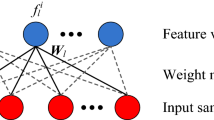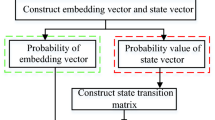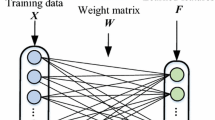Abstract
Purpose
For purpose of automatically diagnosing gear faults, intelligent fault diagnosis methods have been paid increasing attentions by researchers.
Methodology
This paper presents an intelligent fault diagnosis method based on an unsupervised learning algorithm called sparse filtering. First, sparse filtering is employed to extract fault features from gear frequency-domain samples. Then, softmax regression is adopted as a classifier to classify different fault types by the learned features. Finally, two different gear datasets are adopted to testify the validity and feasibility of our method.
Conclusion
The test results appear that our method can not only adaptively extract discriminative characteristics from the spectra of measured signals, but also achieve a superior performance than some other methods.











Similar content being viewed by others
References
Jiang X, Wang J, Shi J et al (2019) A coarse-to-fine decomposing strategy of VMD for extraction of weak repetitive transients in fault diagnosis of rotating machines. Mech Syst Signal Process 116:668–692
Liu H, Huang W, Wang S, Zhu Z (2014) Adaptive spectral kurtosis filtering based on Morlet wavelet and its application for signal transients detection. Signal Process 96:118–124
An Z, Li S, Wang J et al (2018) An intelligent fault diagnosis approach considering the elimination of the weight matrix multi-correlation. Appl Sci 8:906
Ma S, Li S, Liu H et al (2015) Vibration source model estimation and state specificity perception of a rotor structure. J Vib Eng Technol 3(5):575–587
Wang J, Li S, Han B et al (2019) Construction of a batch-normalized autoencoder network and its application in mechanical intelligent fault diagnosis. Meas Sci Technol 30(1):015106
Lee J, Wu F, Zhao W, Ghaffari M, Liao L, Siegel D (2014) Prognostics and health management design for rotary machinery systems—reviews, methodology and applications. Mech Syst Signal Process 42:314–334
Paya B, Esat II (2010) Artificial neural networks based fault diagnostics of rotating machinery using wavelet transforms as a preprocessor. Mech Syst Signal Process 11:751–765
Patan K, Korbicz J (2004) Artificial neural networks in fault diagnosis. Springer, Berlin Heidelberg, pp 333–379
Lu C, Wang Z, Qin W et al (2017) Fault diagnosis of rotary machinery components using a stacked denoising autoencoder-based health state identification. Signal Process 130:377–388
Wang J, Li S, An Z et al (2019) Batch-normalized deep neural networks for achieving fast intelligent fault diagnosis of machines. Neurocomputing 329:53–65. https://doi.org/10.1016/j.neucom.2018.10.049
Tamilselvan P, Wang P (2013) Failure diagnosis using deep belief learning based health state classification. Reliab Eng Syst Saf 115:124–135
Gan M, Wang C et al (2016) Construction of hierarchical diagnosis network based on deep learning and its application in the fault pattern recognition of rolling element bearings. Mech Syst Signal Process 72:92–104
Janssens O, Slavkovikj V, Vervisch B, Stockman K, Loccufier M, Verstockt S, Van de Walle R, Van HS (2016) Convolutional neural network based fault detection for rotating machinery. J Sound Vib 377:331–345
Guo X, Chen L, Shen C (2016) Hierarchical adaptive deep convolution neural network and its application to bearing fault diagnosis. Measurement 93:490–502
Jia F, Lei Y, Lin J et al (2016) Deep neural networks: a promising tool for fault characteristic mining and intelligent diagnosis of rotating machinery with massive data. Mech Syst Signal Process 72:303–315
Ngiam J, Chen Z, Bhaskar S, Koh P, Ng A (2011) Sparse filtering. Proc Neural Inf Process Syst, pp. 1125–1133
Lei Y, Jia F, Lin J, Xing S, Ding S (2016) An intelligent fault diagnosis method using unsupervised feature learning towards mechanical big data. IEEE Trans Ind Electron 63(5):31–37
Jia X, Zhao M, Di Y et al (2016) Investigation on the kurtosis filter and the derivation of convolutional sparse filter for impulsive signature enhancement. J Sound Vib 386:433–448
Tran V, Yang B, Gu F, Ball A (2013) Thermal image enhancement using bi-dimensional empirical mode decomposition in combination with relevance vector machine for rotating machinery fault diagnosis. Mech Syst Signal Process 38:601–614
Jiang M, Liang Y, Feng X et al (2018) Text classification based on deep belief network and softmax regression. Neural Comput Appl 29:61–70
Han J, Zhang D, Wen S, Guo L, Liu T, Li X (2016) Two-stage learning to predict human eye fixations via SDAEs. IEEE Trans Cybern 46(2):487–498
Rafiee J, Arvani F, Harifi A, Sadeghi MH (2007) Intelligent condition monitoring of a gearbox using artificial neural network. Mech Syst Signal Process 21(4):1746–1754
Jiang X, Li S, Wang Y (2015) A novel method for self-adaptive feature extraction using scaling crossover characteristics of signals and combining with LS-SVM for multi-fault diagnosis of gearbox. J Vibroeng 17(4):1861–1878
Acknowledgements
This work was supported by National Natural Science Foundation of China (51675262), Funding of Jiangsu Innovation Program for Graduate Education (KYLX16_0329), the Fundamental Research Funds for the Central Universities (NZ2015103), the Advance research field fund project of China (6140210020102), the Project of National Key Research and Development Plan of China (2016YFD0700800), the Fundamental Research Funds for the Central Universities(NP2018304) and the Major National Science and Technology Projects (2017-IV-0008-0045).
Author information
Authors and Affiliations
Corresponding author
Additional information
Publisher's Note
Springer Nature remains neutral with regard to jurisdictional claims in published maps and institutional affiliations.
Rights and permissions
About this article
Cite this article
Wang, J., Li, S., Xin, Y. et al. Gear Fault Intelligent Diagnosis Based on Frequency-Domain Feature Extraction. J. Vib. Eng. Technol. 7, 159–166 (2019). https://doi.org/10.1007/s42417-019-00089-1
Received:
Accepted:
Published:
Issue Date:
DOI: https://doi.org/10.1007/s42417-019-00089-1




